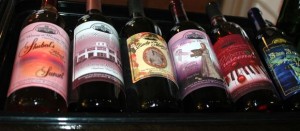 Here is an excerpt of a good article by Julia Burke who not being a fruit wine lover per se, was won over after a bit of research and more importantly a bit of tasting. Being able to discover some great food pairings with the fruit wines she tasted was what did it. Read on…
Here is an excerpt of a good article by Julia Burke who not being a fruit wine lover per se, was won over after a bit of research and more importantly a bit of tasting. Being able to discover some great food pairings with the fruit wines she tasted was what did it. Read on…
Full disclosure: I am not crazy about fruit wines. When I think of the wines of the Niagara Escarpment, visions of riesling, chardonnay, cab franc and ice wine dance in my head; fruit wines, on the other hand, doesn’t get me too excited. I was vaguely aware of their existence but didn’t feel the need to take the relationship to the next level.
But in a wine region that shows remarkable diversity despite its small size, there’s no excuse for closed-mindedness, and after one of our fruit-wine-producing estates represented Niagara USA at a recent tasting event in New York City I made up my mind to at least give fruit wine another chance.
My goal: to find three fruit wines I liked, and figure out a way to use them in a meal.
The Winery at Marjim Manor is unique in Niagara for its focus on fruit wine, and as such was an obvious first stop. With over 20 different types of fruit wine in rotation made primarily from estate fruit, Marjim offers everything from a dry, punchy blueberry wine to a syrupy pear dessert wine. All made by local wine consultant/winemaker Dominic Carisetti, these wines were interesting, tasty and generally well-balanced.
I zeroed in on the Legacy, a tart currant wine which was just a bit too puckery to be quaffed on its own but showed great potential as a food pairing or cooking ingredient. Our server, Chris, was a wealth of pairing suggestions and explained that owner Margo Bittner stresses food pairing as a unique way for fruit wines to shine. “We try different matches and talk about what food would be best with each wine,” she says. The currant wine, I was told, would be a great match for beef or pork.
I found my next fruit wine at Leonard Oakes Estate winery, an up-and-coming winery thats offers two fruit wines as a supplement to a strong list of vinifera and hybrids. Both were outstanding – their Fuji Apple wine was crisp, only slightly sweet, and heavenly with a piece of cheddar cheese, while their Cerise, a carbonated cherry cider, was delightfully refreshing and begged to be mixed into a Christmas morning cocktail. I purchased a bottle of the Cerise, marveling once again at the amazing versatility of winemaker Jonathan Oakes.
My final stop was Honeymoon Trail Winery, a haven for sweet wine lovers with few wines dropping below 2% residual sugar. Most of the wines, made by owner Gary Hoover, were too sweet for my palate, but I had a few dessert ideas for their Frozen Cherry wine, which balanced its sugar with a nice acidity.
I had my three wines, and it was time to start cooking.
Creating a dish starring Marjim Manor’s Legacy was a no-brainer: I added chicken broth, brown sugar, chopped dried apricots, and cornstarch to a reduction of the currant wine to make a delicious fruit sauce for pork tenderloin. While the recipe was a hit with my test kitchen (my family), everyone agreed that the wine went down easier in sauce than in the glass. While it’s a welcome change from the sweeter fruit wines, it’s a bit too tart to be a quaffer.
For dessert I deep-fried and caramelized some banana coins and made my world-famous hot fudge to drizzle on top. My plan was to blend in some Frozen Cherry, but the wine ruined the consistency of the hot fudge. I tried serving it as a dessert drink in cordial glasses along with the banana coins, but it was too sweet for anyone at the table. A flourless chocolate cake might have been a better match.
I cook best with a glass of wine or beer in hand, so while my coins were deep-frying I started playing with fruit wines and vodka. I found that currant wine and vodka make a terrific combination, and realized that perhaps this was an even better avenue for fruit wines: mixed drinks!
In search of a new group of guinea pigs, I brought a mini bar to work the next day: vodka, Cava, Cerise, Legacy, and Frozen Cherry. In lieu of an employee Christmas party we began mixing different combinations, and it became clear that fruit wines are a wonderful bar ingredient.
While Frozen Cherry and Cava was nice and my Legacy/vodka cocktail went over well, the very best drink was Cava and Cerise. The tart, sparkly cherry and the subtly-flavored bubbly were a delightful combination, and with its bright-red hue the cocktail looked especially festive in a tall, thin glass. We drank a toast to on-the-job drinking and went back to work, productivity increased by the antioxidants we’d consumed.
I have to admit that these three fruit wines won me over with their versatility as ingredients in food and drink. Fruit wines, especially if they’re made from fruit grown on the estate, have a definite niche in Niagara that shows off another side of our fertile region.
Article and Photo by Julia Burke
